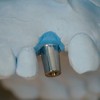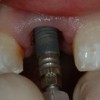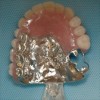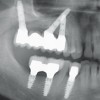This presentation addresses diagnosis and treatment planning, tooth preparation, design, thickness and fit and cementation (bonding) of resin bonded prostheses. All clinical steps are illustrated in detail including tooth preparation, design, metal thickness, fit and bonding, Clinical outcome data with respect to tooth discoloration and debonding are presented.
Transcript
- 1. Charles J. Goodacre, DDS, MSD Professor of Restorative Dentistry Loma Linda University School of Dentistry This program of instruction is protected by copyright ©. No portion of this program of instruction may be reproduced, recorded or transferred by any means electronic, digital, photographic, mechanical etc., or by any information storage or retrieval system, without prior permission. Optimizing success with resin bonded prostheses
- 2. • Rochette • Acid Etched • Resin Retained Resin bonded prostheses names • Etched Cast • Maryland • Virginia
- 3. Resin Bonded Prosthesis Success • Diagnosis & Treatment Planning • Tooth Preparation • Design, thickness, fit • Cementation (Bonding)
- 4. RBP Complications Incidence • 48 studies • 1823 of 7029 prostheses had complications • Mean of 26% • 1-4 years (25%) • 5+ years (28%)
- 5. Most Common RBP Complications • Debonding (21%) • Tooth discoloration (18%) • Caries (7%) • Porcelain fracture (3%) • Periodontal health (N.S.)
- 6. RBP Debonding (Evaluated in 49 Studies) • 1481 of 7029 prostheses debonded • Mean of 21% • Range from 0.0 to 52%
- 7. Systematic Review of RBP • Review included 17 publications • 19% debond rate after 5 years • Annual debond rate of 5% on posterior teeth versus 3% on anterior teeth Pjetursson, Clin Oral Imp Res 2008;19:141-141
- 8. Debond Rates Over Time • Initially a higher debond rate • Then a decrease up to 5 years • Increased rate after 5 years • “Wearin” for the first 5 years • “Wearout” after 5 years Boyer, 1993
- 9. Debonding should not be considered a failure since rebonding does not constitute significant investment or inconvenience to patients or dentists Priest, 1988 Do you agree?
- 10. RBP Span Length (Evaluated in 8 Studies) • Mean debond rate of 25% with short spans • Mean debond rate of 52% when more than 3 units, more than 1 pontic or prostheses with more than 2 retainers
- 11. Span Length & Debonding • Increased debonding with multiple pontics Dunne, 1993 Mudassir, 1995 • Increased debonding with 4 or more units Probster, 1997
- 12. Toooo Wide
- 13. Occlusal Forces (Evaluted in 7 Studies) • In 2 studies, 70% and 45% of debonding caused by heavy occlusal forces • In 5 studies, 22% (31 of 143 debonds) of debonds caused by heavy occlusal forces
- 14. Maxillary/Mandibular Debond Rates (Evaluated in 27 Studies) • á in maxilla (6 studies) • á in mandible (8 studies) • No significant difference in 13 studies • No conclusive trend
- 15. Anterior / Posterior Debond Rates (Evaluated in 23 Studies) • á Anteriorly in 4 studies • á Posteriorly in 8 studies • No significant difference in 11 studies • No conclusive trend
- 16. Affect of Gender on Debonding (Evaluated in 8 Studies) • No significant difference in 5 studies • Higher male debond rate in 3 studies • Possible male trend
- 17. Affect of Age on Debonding (Evaluated in 6 Studies) • Higher debond rate in young patients in 4 studies • No significant difference in 2 studies • Possible age trend
- 18. Affect of Incisally Positioned Gingiva Produces Short Clinical Crowns
- 19. RBP Abutment Tooth Discoloration (Evaluated in 7 Studies) • 62 of 343 prostheses affected • Mean of 18% • Range from 3 to 37% • Increases with time
- 20. Tooth Discoloration • 21% had incisal discoloration Williams, 1984 • 37% concerned with shade / color Thayer, 1993 • 13% had gray abutments Gilmour, 1995
- 21. Tooth Discoloration • Increases with time 4% after 7 years 25% after 10 years 37% after 15 years Thayer, 1993
- 22. The lingual metal produces discoloration, particularly through translucent portions of the abutment teeth
- 23. RBP Caries (Evaluated in 22 Studies) • 242 of 3426 prostheses had caries • Mean of 7% • Range from 0.0 to 12% • None in 9 studies (2 mos. – 59 mos.) • < 2% in 6 studies (2 mos. – 5 yrs. 8 mos.) • 2.5 – 12% in 7 studies ( 2.5 – 10 yrs.) • Most associated with debonding
- 24. RBP Porcelain Fracture (Evaluated in 15 Studies) • 38 of 1126 prostheses affected • Mean of 3% • Range from 0.0 to 8%
- 25. RBP and Periodontal Health (Evaluated in 14 Studies) • No problems noted in 6 studies • Mild, nonsignificant changes in 4 studies • Significant but not clinically relevant changes in 4 studies
- 26. All resin bonded prostheses are overcontourted. The reason there is not more of a negative affect is that the overcontouring is usually located incisal to the gingival margin.
- 27. Cantilever Designs • 54 cantilever prostheses in 47 patients • 27 months mean postplacement time • 11 prostheses debonded (20%) • 8 of 11 were successfully rebonded Briggs, 1996
- 28. Cantilever Designs • Did not affect survival Leempoel, 1995 • Lower debond rate associated with cantilever design Hussey, 1991
- 29. Cantilever Success Data • 32% debond rate when the maxillary central incisor was cantilevered from the central incisor or the lateral incisor (28 prostheses) Hussey, 1996
- 30. Cantilever Success Data • 3 year mean postplacement time • 12% overall debond rate • 24% debond rate when the maxillary canine was cantilevered from the first premolar (17 prostheses) Hussey, 1996
- 31. Cantilever Success Data • 6% debond rate when the maxillary lateral incisor was cantilevered from the canine (63 prostheses) Hussey, 1996
- 32. • 6% debond rate when the maxillary lateral incisor was cantilevered from the canine (63 prostheses) Hussey, 1996
- 33. Cantilever Designs Have Been Successfully Used since 1988 by Dr. John Locke, Prosthodontist in Melbourne, Australia
- 34. Cantilever Success Data • No debonds when a maxillary premolar was cantilevered from the other premolar (8 prostheses) Hussey, 1996
- 35. Cantilever Success Data • No debonds with 26 mandibular prostheses Hussey, 1996
- 36. Cantilever with Splinted Retainers due to Orthodontic Rotation of Maxillary Canine
- 37. Other DxTP Considerations • Intact / minimally restored abutments
- 38. Other DxTP Considerations • Intact / minimally restored abutments • Normal MD space
- 39. Other DxTP Considerations • Intact / minimally restored abutments • Normal MD space • Normal contours
- 40. Other DxTP Considerations • Intact / minimally restored abutments • Normal MD space • Normal contours • Avoid splinting
- 41. Avoid Splinting & Multiple Adjoining Retainers • The number of retainers and splinting increases the debond rate Marinello, 1987 Olin, 1990 Dunne, 1993
- 42. Other DxTP Considerations • Intact / minimally restored abutments • Normal MD space • Normal contours • Avoid splinting • Avoid mobile abutments
- 43. Debonding & Mobility • Mobility causes some of the debonds Ferrari, 1989 • Mobility increased the debond rate Probster, 1997
- 44. Other DxTP Considerations • Intact / minimally restored abutments • Normal MD space • Normal contours • Avoid splinting • Avoid mobile abutments • Minimal translucency
- 45. Resin Bonded Prosthesis Success • Diagnosis & Treatment Planning • Tooth Preparation • Design, thickness, fit • Cementation (Bonding)
- 46. Resin bonded prostheses were originally introduced by Rochette as a prosthesis requiring little or no tooth preparation. However, most of the clinical studies that evaluated the effects of tooth preparation indicate it decreases the incidence of debonding and therefore increases prosthesis longevity
- 47. Effect of Tooth Preparation (Evaluated in 9 Studies) • No significant effect in 3 studies • Significant debonding in 5 studies – 11% debond when prepared – 47% debond with no preparation
- 48. 1. Cover Maximal Enamel Area Need Teeth With Adequate Enamel Surface Area
- 49. Effect of Bonding Area • The area available for bonding affects success Thayer, 1993 Priest, 1995 Ferrari, 1998 • The mean area of debonded retainers was 38 mm2 compared to retainers that did not debond (45 mm2) Thayer, 1993 • Age and gingival position affected the area available for bonding
- 50. Prosthesis failure due to minimal coverage More appropriate area covered
- 51. When the gingival tissue covers the cingulum, it should be surgically removed prior to placement of a resin bonded prosthesis so the maximal amount of tooth structure is available for coverage.
- 52. 2. Cover the lingual and proximal surfaces of each abutment
- 53. 3. Prepare the proximal surfaces so they are convex faciolingually.
- 54. 4. Create adequate occlusal clearance so the metal casting can possess adequate rigidity (0.5 millimeter minimum). In situations where there is tight interdigitation of opposing teeth, it may be necessary to modify opposing enamel surfaces to create sufficient clearance.
- 55. 0.5 mm minimum 4. Create adequate reduction of the occluding surface so there is sufficient material thickness.
- 56. 5. Form a perpheral finish line (0.2 – 0.3 mm) that provides positional stabiliy, increases casting rigidity, and decreases overcontouring.
- 57. • Because the cervical enamel thickness on mandibular incisors is minimal (0.1 – 0.3 mm), placement of a chamfer finish line is not recommended because it may remove all the cervical enamel and adversely affect the bond.
- 58. Ledge 6. Form lingual ledges or occlusal rests seats that provide positional stability, increased resistance form and increased metal rigidity.
- 59. Posterior Tooth Preparations • 180° axial coverage Creugers, 1989 Crispin, 1991
- 60. Posterior Tooth Preparations • Tooth preparation should include multiple rests Barrack, 1993 • Tooth preparation can cover the entire lingual cusp with proximal grooves
- 61. Rest seats should resemble the tip of a spoon, having greater faciolingual dimension at the marginal ridge and taper toward the center of the tooth. They should extend about 1/3rd of the distance across the occlusal surface.
- 62. 0.5 mm The rest seat depth should provide for at least 0.5 mm of occlusocervical metal thickness at the marginal ridge of the rest seat..
- 63. The cervical floor of the rest seat should slope apically from the marginal ridge toward the center of the tooth just like a rest seat in a crown for a removable partial denture.
- 64. Grooves 7. Form proximal grooves that provide resistance form, positional stability, and increased casting rigidity.
- 65. Proximal Grooves • The use of proximal grooves decreases debonding Simon, 1992 Rammelsberg, 1993 Besimo, 1993 Barrack, 1993 • Use a number 700 bur and place proximal grooves to an apical depth that equals one-half the diameter of the bur tip
- 66. • Pinholes can also be used and they are prepared by first drilling a hole using a number ½ round bur to the desired depth of 1.5 to 2.0 mm and then using a number 700 bur to create the slightly tapered form
- 67. Proximal Groove combined with Lingual Groove(s) • One proximal groove • One or two lingual grooves (channels / furrows) that are 1 mm deep • ½ round bur to penetrate enamel and then 168 bur to refine lingual furrows • Technique developed by Dr. John Locke, Prosthodontist, Melbourne, Australia Courtesy of J Locke
- 68. Maxillary Canine
- 69. Maxillary Central Incisor
- 70. Mandibular Incisor
- 71. Courtesy of J Locke
- 72. Courtesy of J Locke
- 73. Key Tooth Preparation Features • Cover maximal area • Cover lingual and proximal • Convex proximal surfaces • Adequate occlusal clearance • Peripheral finish line • Ledges / rests • Multiple grooves or single groove with slot(s) • Pinholes can be used All These Features Produce A Definite Path Of Placement & Resistance To Dislodgement
- 74. • Chamfer finish line – 0.2 – 0.3 mm deep • Proximal grooves – apical depth of ½ the tip diameter of a number 700 bur • Reduction for occlusal clearance – 0.5 mm minimal clearance • Lingual ledges (ant. teeth) – 0.2-0.5 mm deep • Occlusal rests (posterior teeth) – 0.5 mm minimal thickness at the marginal ridge, extend 1/3 of the MD dimension of the occlusal surface, and slope apically toward the tooth center • Pinholes (1.5 – 2.0 mm deep) can be used Key Tooth Preparation Features
- 75. Resin Bonded Prosthesis Success • Diagnosis & Treatment Planning • Tooth Preparation • Design, thickness, fit • Cementation (Bonding)
- 76. Metal Thickness & Fit • The space created for occlusal clearance should be at least 0.5 mm • Metal thickness over marginal ridges should be 1.0 mm or more • The internal adaptation need to be excellent so the retentive features can engage tooth structure
- 77. Resin – Metal Retention • Macroscopic retention perforations
- 78. Resin – Metal Retention • Macroscopic retention Perforations Meshes
- 79. Resin – Metal Retention • Macroscopic retention Perforations Meshes Internal undercuts Salt crystal technique Virginia bridge
- 80. 150 – 250 micrometer salt crystals produced the highest bond strengths Moon, 1987
- 81. Resin – Metal Retention • Macroscopic retention Perforations Meshes Internal undercuts • Microscopic retention Electrolytic etching
- 82. Resin – Metal Bond • Electrochemical etch is best LaBarre, 1984 Brantley, 1986 Creugers, 1986
- 83. Resin – Metal Retention • Macroscopic retention Perforations Meshes Internal undercuts • Microscopic retention Electrolytic etching Chemical etching Electrolytically and chemically etched bond strengths were the same. Three chemical etchants were equally effective Aquilino, 1990
- 84. Resin – Metal Retention • Macroscopic retention Perforations Meshes Internal undercuts • Microscopic retention Electrolytic etching Chemical etching Airborne particle abrasion Airborne particle abrasion and electrochemically etched surfaces were the same Atta, 1986 Covington, 1987
- 85. Resin – Metal Bond Consensus • Method of metal treatment is not critical • The enamel – resin bond is the weak link Shaw, 1982 LaBarre, 1984 Aksu, 1982 Holland, 1984
- 86. Resin Bonded Prosthesis Success • Diagnosis & Treatment Planning • Tooth Preparation • Design, thickness, fit • Cementation (Bonding)
- 87. Cementation (Bonding) • Meticulous isolation and attention to detail is required Crispin, 1986
- 88. Cementation (Bonding) • The usual enamel etching is performed and visually verified.
- 89. Cementation (Bonding) • If the etched enamel becomes contaminated by saliva, the surface should be re-etched since only drying caused decreased bond strengths Hormati, 1980
- 90. Cementation (Bonding) • If the etched metal surface becomes contaminated by saliva, it can be dried since research has shown that drying has no harmful effect on bond strength Ballesteros, 1986 Cassidy, 1987
- 91. Select A Chemically Polymerized Resin Cement
- 92. Cementation (Bonding) • Follow the manufacturer’s instructions regarding bonding procedures.
- 93. Cementation (Bonding) • Remove the excess resin before it polymerizes, particularly the interproximal excess
- 94. Cementation (Bonding) • 32% of the prostheses exhibited excess resin gingivally Thayer, 1993
- 95. Cementation (Bonding) • Finishing / polishing the metal for 30 seconds with a bur and 20 seconds with a brown rubber cup significantly decreased the bond strength • Most finishing should be completed prior to bonding Caughman, 1988
- 96. Rebonding Prostheses • Remove existing resin using airborne particle abrasion with 50 micrometer aluminous oxide particles • Rebonded prostheses have a higher debond rate Kerschbaum, 1996
- 97. Believe in “good luck”, but also believe it happens most often to those who work hard and keep their eyes open. Thank You Charles J. Goodacre, DDS, MSD Professor of Restorative Dentistry Loma Linda University School of Dentistry
- 98. v Visit ffofr.org for hundreds of additional lectures on Complete Dentures, Implant Dentistry, Removable Partial Dentures, Esthetic Dentistry and Maxillofacial Prosthetics. v The lectures are free. v Our objective is to create the best and most comprehensive online programs of instruction in Prosthodontics


 Cement Retention vs Screw Retention
Cement Retention vs Screw Retention
 Single Tooth Defects in Posterior Quadrants
Single Tooth Defects in Posterior Quadrants
 Implants and RPDs
Implants and RPDs
 Restoration of Posterior Quadrants and Treatment Planning
Restoration of Posterior Quadrants and Treatment Planning
